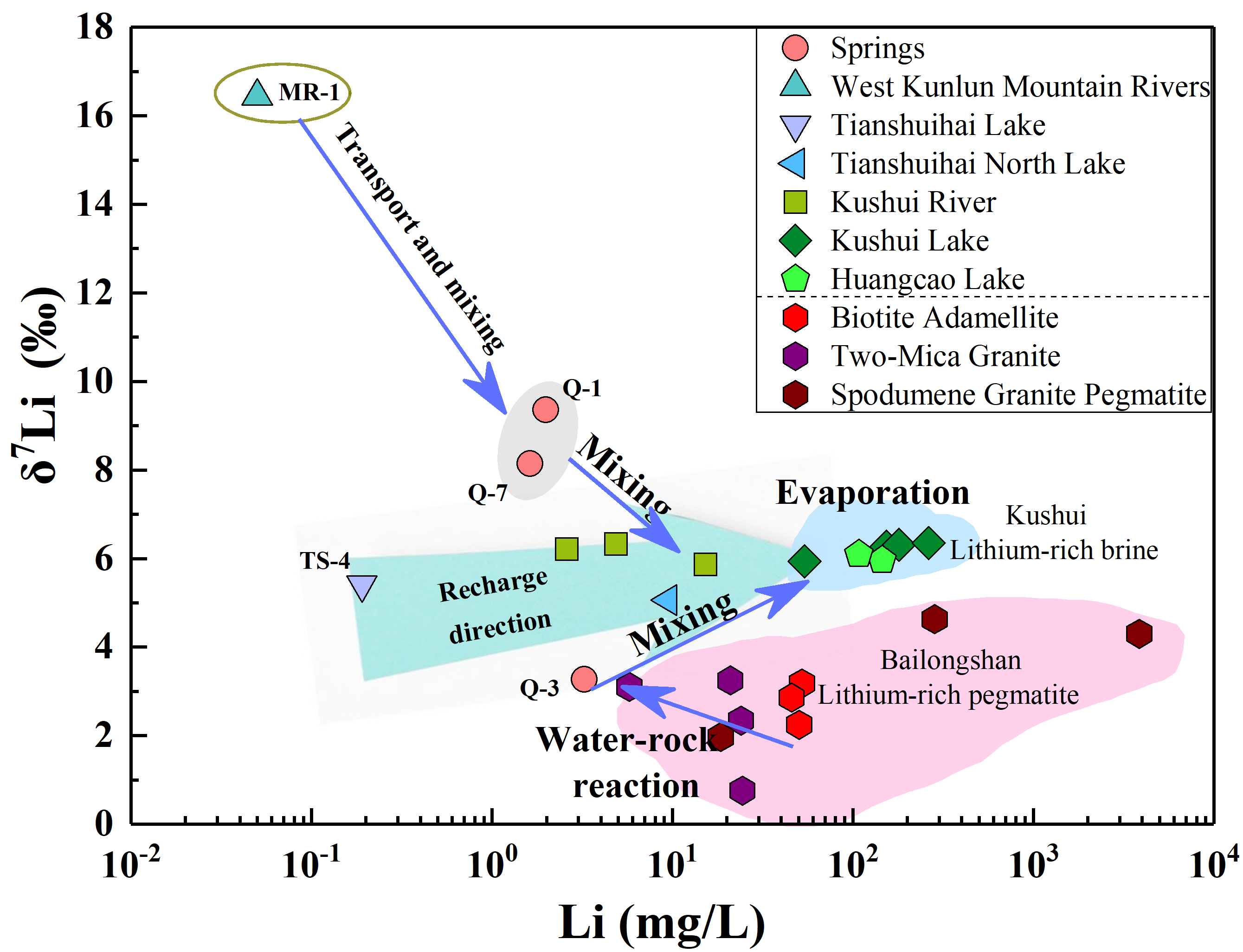In recent years, several super-massive pegmatite deposits have been discovered in the West Kunlun region of the Tibetan Plateau. At the same time, many lithium-rich salt lakes developed in intermountain basins in this region, such as the typical Kushui Lake, Huangcao Lake and others. These brine-type lithium deposits and adjacent pegmatite-type lithium deposits are ideal cases to study the genetic mechanisms of lithium-rich salt lakes and their relation to pegmatite-type lithium deposits in this region.
The research team from the Laboratory of Geology and Environment of Salt Lakes of Qinghai Institute of Salt Lakes, Chinese Academy of Sciences, conducted a systematic field geological survey and sample collection for the aforementioned typical salt lakes. Based on the analysis of hydrochemistry and isotope geochemistry, the sources, distribution characteristics, migration and enrichment rule of lithium from "source" to "sink" in the lithium-rich fluids in this area were preliminarily determined, and the correlation between brine-type lithium deposits and pegmatite-type lithium deposits was discussed. In addition, a metallogenic conceptual model was developed for typical salt lake lithium deposits in the intermountain basin of West Kunlun. This study is a new achievement in the recent research on the genetic mechanism of brine-type lithium deposits in the Tibetan plateau.
The results show that the hydrochemistry composition and sources of elements of rivers in the catchment are controlled by the weathering of evaporite and silicate rocks, which are closely related to the widely distributed felsic igneous rocks of this region. In particular, the abundance of typical hydrothermal enriched elements (Co, Ni, Cs, etc.) in springs is several times higher than that in other recharge rivers, and there is a positive correlation with Li molarity, indicating that deep geothermal fluids in the study area also provide abundant sources of rare elements for the lake. The results of lithium isotope analysis show that the characteristics of high Li concentration and low δ7Li value in the lithium-rich brine are mainly the result of hydrothermal water-rock interaction in the deep crust and weathering in the near-surface.
In addition, with the migration of surface lithium-rich fluids, the soluble lithium showed a trend of continuous enrichment during the process of constant evaporation and runoff mixing, indicating that the deep lithium-rich fluids inflow and intense evaporation under drought conditions were the main mechanisms of rapid lithium enrichment in salt lakes. The positive correlation between Li concentration and δ7Li value along the recharge direction indicates that the adsorption effect of secondary minerals on 6Li still exists even at the small watershed scale in the alpine environment, which leads to a certain degree of lithium isotope fractionation.
This study contributes to the further understanding of the sources and enrichment processes of lithium in lithium-rich salt lakes, and provides new evidence for an in-depth understanding of the genetic mechanisms of brine-type lithium deposits. At the same time, it also provides a brand-new idea to guide the search for hidden hard-rock-type lithium deposits or potential brine-type lithium deposits.
These findings were recently published in the Ore Geology Reviews under the title of Origin of lithium-rich salt lakes on the western Kunlun Mountains of the Tibetan Plateau: Evidence from hydrogeochemistry and lithium isotopes. Dr. Yulong Li is the lead author and Dr. Xiying Zhang is the corresponding author. Dr. Maoyong He from the Earth Environment Research Institute of the Chinese Academy of Sciences and Dr. Weiliang Miao from the Qinghai Institute of Salt Lake of the Chinese Academy of Sciences were essential contributors and co-authors of this study. This work was supported by the National Natural Science Foundation of China (U22A20573), the Second Tibetan Plateau Scientific Expedition and Research (STEP) (2019QZKK0805), the Western Light Foundation of Chinese Academy of Sciences, the Shaanxi Provincial Natural Science Foundation for Distinguished Young Scholars (2022JC), and the Youth Innovation Cross Team of Basic Research Program of Qinghai Institute of Salt lakes, CAS (ISLJCTD-2022-2).
Link address for full text: https://doi.org/10.1016/j.oregeorev.2023.105356

Figure 1. Diagram of the relationship of Li concentration and δ7Li between different water samples, surrounding bedrock and pegmatitic lithium deposits in Kushui Lake catchment.

Figure 2. Migration and enrichment process of lithium and its evolution rules in the Kushui Lake catchment.
